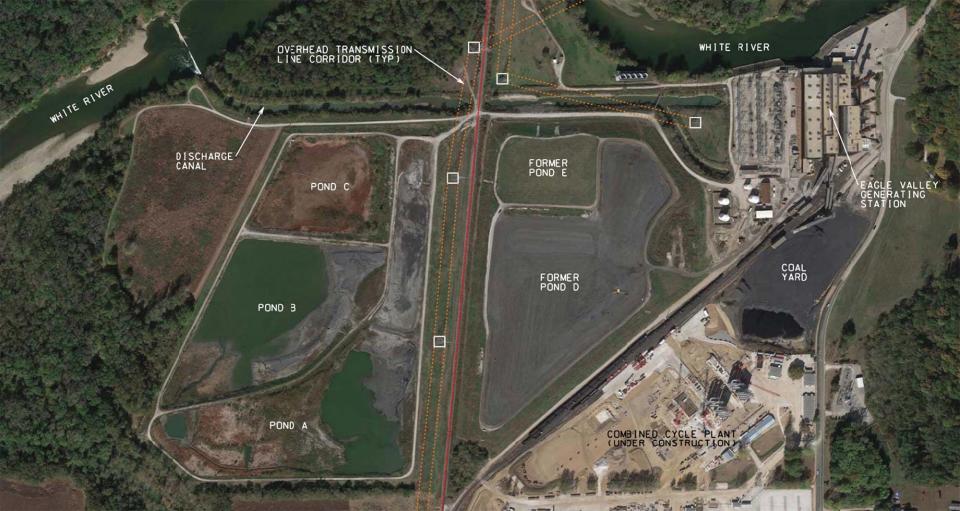Martinsville coal ash plant highlighted as dangerous to water sources in new report
More than a dozen coal ash impoundments in Indiana continue to threaten state waterways with cancer-causing metals and other toxic pollution years after they stopped receiving new coal ash, according to a new report.
The report, by the Environmental Integrity Project and Earthjustice, compiled federally mandated monitoring data submitted by the companies that operate coal ash impoundments, large dirt pits where the spent ash from coal burned by power plants was placed for decades.
According to the report, about 500 impoundments, also called coal ash ponds, and landfills where coal ash is dumped exist at 292 sites across the U.S., including dozens at 16 Indiana power plant sites.
More in news:Mooresville Town Council passes 2023 salary ordinance
“In every state where coal is burned, power companies are violating federal health protections,” said Lisa Evans, senior attorney at Earthjustice. “Coal plant owners are ignoring the law and avoiding cleanup because they don’t want to pay for it. Coal ash waste is causing widespread water contamination that threatens drinking water supplies and the environment.”
A 2015 U.S. Environmental Protection Agency rule required those power plants to assess the structural stability of the impoundment periodically, install monitoring wells and establish testing procedures for groundwater protection, keep records and post them online, and close the ponds after a maximum of two years after receiving their last coal ash. The Trump administration modified the rule to be more lenient, allowing some impoundments to avoid having to pay for a site cleanup by allowing them to stay open for a longer time.
The report found that 91% of all coal-fired power plants in the U.S. have impoundments that are leaking carcinogenic arsenic and other toxic heavy metals like lead, mercury and selenium into groundwater near rivers, streams and drinking water aquifers.
Most of the ponds are unlined, meaning there is almost nothing to stop the ash from seeping into groundwater or nearby waterways.
Nearly all the power plants, or about 96%, have no plans to clean affected groundwater, and only about half agree that a cleanup is necessary at all.
More:County soil and water district discusses AES coal ash pits
The impoundments have already negatively affected Hoosiers, and more are threatened.
"Coal ash has already contaminated drinking water wells in four Indiana communities, threatened drinking water in a fifth, and has rendered groundwater unusable at 10 other sites. The cleanups required by the rule have to happen to stop the damage to our state’s natural resources,” said Dr. Indra Frank, Hoosier Environmental Council environmental health and water policy director.
The report ranked the level of pollution emitted at all 292 sites. Martinsville's Eagle Valley Generating Station came in at No. 136.

Eagle Valley Generating Station
The AES Indiana Eagle Valley Generating Station was converted to natural gas, but a single coal ash impoundment with three coal ash ponds remains at the plant site.
The ponds have reported high levels of arsenic, boron, lithium and molybdenum at the site, and all three ponds have been identified as having “significant hazard potential.”
More:County soil and water district discusses AES coal ash pits
The plant experienced at least two failures at the impoundments that sent a mixture of coal ash and water called ash sluice into the White River. On Feb. 14, 2007, a levee failure released 30 million gallons of ash sluice, and a failure on Jan. 30, 2008 released an additional 30 million gallons of ash sluice into the White River. The plant also had smaller releases that same year.
The company had to pay a $23,800 civil penalty and perform a study of its ash pond levees. The company did not have to perform a cleanup of the ash sluice and even petitioned the EPA to lower the risk classification for the coal ash pond that failed from “high” to “significant.”
AES Indiana began closing the impoundment in 2020. The impoundments will be closed in place, and the coal ash will remain on site.
This article originally appeared on The Herald-Times: Reports say Eagle Valley coal ash ponds have 'hazard potential'

